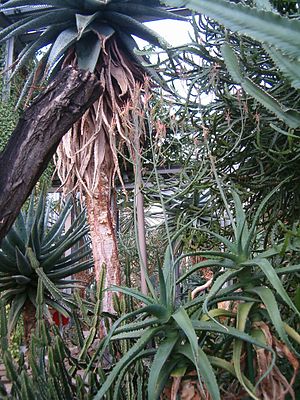Aloe megalacantha
| Aloe megalacantha | ||||||||||||
|---|---|---|---|---|---|---|---|---|---|---|---|---|

Aloe megalacantha |
||||||||||||
| Systematics | ||||||||||||
|
||||||||||||
| Scientific name | ||||||||||||
| Aloe megalacantha | ||||||||||||
| Baker |
Aloe megalacantha is a species of aloes in the subfamily of the Affodilla family (Asphodeloideae). The specific epithet megalacantha is derived from the Greek words megas for 'large' and acantha for 'sting' and refers to the large teeth on the edge of the leaf.
description
Vegetative characteristics
Aloe megalacantha grows trunk-forming and branches from the base. The splayed trunk reaches a length of up to 2 meters and is covered with dead leaves. The 24 or more lanceolate, narrowed leaves form dense rosettes . They are persistent at about 50 centimeters of the trunk length. The cloudy, light green to bluish green leaf blade is 60 to 80 centimeters long and 13 to 15 centimeters wide. It is deeply rutted and bent back. Their tips point downwards. The leaf surface is rough. The blunt, pinkish-red, reddish-brown, pointed teeth on the pinkish-red, cartilaginous leaf margin are 4 to 6 millimeters long and 0.5 to 0.7 millimeters apart.
Inflorescences and flowers
The inflorescence consists of six to 13 branches and reaches a length of 50 to 100 centimeters. The lower branches are branched again. The rather dense, cylindrical-conical grapes are 5 to 14 inches long and 7 inches wide. The ovoid-deltoid bracts are 4 to 7 millimeters long and 2 to 4 millimeters wide. The yellow, orange or scarlet flowers are on 8 to 15 millimeter long peduncles . The flowers are 23 to 28 millimeters long and rounded at their base. At the level of the ovary , the flowers have a diameter of 5 to 7 millimeters. Above this they are very slightly narrowed and finally slightly expanded towards the mouth. Your outer tepals are not fused together over a length of 12 to 14 millimeters. The stamens and the pen stand out 3 to 4 millimeters from the flower.
genetics
The number of chromosomes is .
Systematics and distribution
Aloe megalacantha is common in Ethiopia and Somalia .
The first description by John Gilbert Baker was published in 1898. The following subspecies are distinguished:
- Aloe megalacantha subsp. megalacantha
- Aloe megalacantha subsp. alticola M.G. Gilbert & Sebsebe
Aloe megalacantha subsp. megalacantha
The subspecies is distributed in the northeast of Ethiopia and in the northwest of Somalia in dry open bushland on rocky slopes and on sandy plains at altitudes of 1100 to 1850 meters. Aloe magnidentata I. Verd . & Christian (1947) was included as a synonym in the subspecies.
Aloe megalacantha subsp. alticola
The differences to Aloe megalacantha var. megalacantha are: The subspecies often forms more compact clumps. The trunks are upright. The teeth on the edge of the leaf are about 4 millimeters long. The bracts have a length of 11 to 12 millimeters and are 2.5 to 4 millimeters wide. The flowers are 28 to 30 millimeters long. At the level of the ovary, the flowers are 4 to 6 millimeters in diameter. Your outer tepals are not fused together over a length of 10 to 12 millimeters.
The first description of the subspecies by Michael George Gilbert and Sebsebe Demissew was published in 1997. Aloe megalacantha subsp. alticola is widespread in Ethiopia in the southern Hararghe region on the edge of thickets on limestone slopes at altitudes of 2100 to 2150 meters.
proof
literature
- Susan Carter , John J. Lavranos , Leonard E. Newton , Colin C. Walker : Aloes. The definitive guide . Kew Publishing, Royal Botanic Gardens, Kew 2011, ISBN 978-1-84246-439-7 , pp. 630 .
- Leonard Eric Newton: Aloe megalacantha . In: Urs Eggli (Hrsg.): Succulent lexicon. Monocotyledons . Eugen Ulmer, Stuttgart 2001, ISBN 3-8001-3662-7 , pp. 157-158 .
Individual evidence
- ↑ Urs Eggli, Leonard E. Newton: Etymological Dictionary of Succulent Plant Names . Springer, Berlin / Heidelberg 2010, ISBN 978-3-642-05597-3 , p. 150.
- ^ In: Daniel Oliver: Flora of Tropical Africa . Volume 7, Part 3, 1898, p. 469 ( online ).
- ^ Kew Bulletin . Volume 52, number 1, 1997, p. 150.
